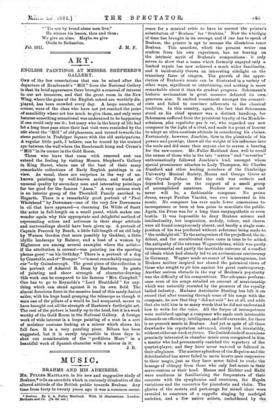ART.
.ENGLIS11 PAINTINGS AT MESSRS. SHEPHERD'S GALLERY.
Owe of the •few consolations that can be seized after the departure of Rembrandt's "Mill" from the National Gallery is .tbat its brief appearance there brought areuewal of interest in. our art treasures, and that the great room in the New Wing, where the gems of the English school are worthily dis- played, has been crowded every day. A large number, of course, were of the class who have not yet reached the point of sensibility where art has much to give them, and only went because something sensational was understood to be happening if could only see it ; but many who in the hurry of life had let a long time pass since their last visit were reminded by the stir about the "Mill" of old pleasures, and turned towards the stone portico in Trafalgar Square with the old anticipations. Ategular little path, I believe, can be traced by the trained eye between the wall where the Rembrandt hung and Creme's " Mill" in its corner in the Gold Room.
-Those who leave that room with renewed zest can extend the feeling by visiting Messrs. Shepherd's Gallery in King Street, where one of the hest of their many remarkable collections of Early English paintings is on view. As usual, there are surprises in the way of un- known paintings by well-known artists, and works of unusual quality by secondary men and interesting paintings far too good for the famous "Anon." A very curious work is an interior group of the Thornhill Family ascribed to Hogarth. There is a remarkably good portrait of "Paul Whitehead" by Downma.n—one of the very few Downmane in oil that have appeared—a charming De. Wilde of Snett the- actor in full-length- on a small panel, which makes one wonder again why this appropriate and delightful method of rePresenting actors and actresses in their stage attitude and surroundings should have been given up. A portrait of Captain Peacock by Beach, a little full-length of an old lady by Watson Gordon (but more possibly- by Geddes), a little idyllic landscape by Balmer, and a bust of a woman by Hlghmore are among several examples where the artist-- if the attribution is correct—was painting (as the sporting phrase goes) " on his birthday." There is a portrait of a dog by Constable, and of "Bumper "—"a most remarkably sagacious cur "—by Gaineborough. The great piece of the collection is the portrait of Admiral B.. Dean by Raeburn. In gusto of painting and sheer strength of . character-drawing this work can be compared to his 'famous "Mrs. Campbell." One has to go to Reynolds's " Lord Heathfield " for any- thing which can stand against it in its own field. The almost ferocious force in the massive head of this sandy-haired sailor, with his huge hand grasping the telescope as though it were one of the pillars of a world he had conquered, seems to have brought out all the strength of Raeburn's forthright art. The rest of the picture is hardly np to the head, but it is a work worthy of the Gold Room in the National Gallery. A foreign work of wide interest is .a large painting of a man in a sort of muleteer costume looking at a mirror which shows his full face. It is a very puzzling piece. Ribera has been suggested, but it is surely impossible in these days to shut out consideration of the " perfidious Ma.zo " in a beautiful work of Spanish character with a mirror in it.
J. B.










































 Previous page
Previous page